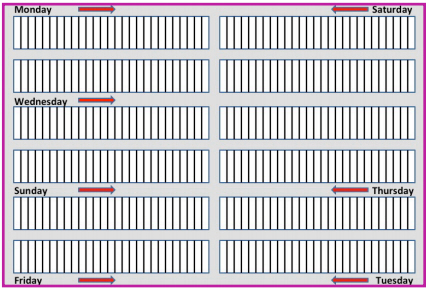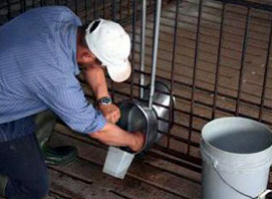



Daily Walking Swine Breeding-Gestation and Farrowing Barns
Advice on how to check and inspect breeding pigs by Don Levis of Worldwide Swine Consultancy in the 'How To' series from Pork Information Gateway.Introduction
Regardless of whether a caretaker is walking a barn used for gilt development, breeding-gestation or farrowing, the facility has to be observed and evaluated at the barn level, pen or stall level, and individual pig level.
The main reason for walking a barn is to identify problems, determine why the problem is occurring, and take action to solve the problem.
A walk-through requires the caretaker to make observations, listen to sounds, smell odours, feel/take room temperatures, measure relative humidity and touch objects.
The morning walk-through is usually more thorough because of the detailed observation of each individual animal, feeding system, watering system and environment. The afternoon walk-through is less intense and mainly involves an evaluation of animal comfort, water availability, feed availability, and adequate ventilation.
Caretakers need to apply their knowledge to solve the problems.
Objectives
To provide caretakers with information on how to look for factors that may be a problem at the barn level, pen level and individual pig level while walking through a barn.
Barn Level
Because the breeding-gestation animals are limit-fed, the walk-through starts after the animals have eaten. Problems identified may be corrected at the time of the walk-through or later in the day. A walk-through should start at a different location each day (Figure 1).

- Record the air temperature from hanging thermometers at various locations within the building.
- Observe breathing and lying behaviour to determine whether the barn temperature provides comfort for the animals.
- Identify “hot spots” in the barn by continuous awareness of temperature changes felt.
- Look for signs of high relative humidity (wetness on ceiling, walls or equipment).
- Evaluate whether the barn has abnormal smells/odours (high ammonia) or dust level.
- Look at all minimum ventilation fans in the wall to ensure they are properly working.
- Ensure all ventilation fans assigned to operate at the current barn temperature are working.
- Look for cleanliness on both sides of fan blades and shutters. Ensure shutters are properly working and
- closed on non-running fans.
- Look at all the air inlets to ensure they are correctly working for the current room temperature.
- Observe whether the sidewall curtain is at the correct location for the current temperature. It may be essential to determine whether the curtains are operational.
- Look for sagging curtains and holes in closed sidewall curtains
- In a naturally ventilated barn look at all air inlets, air outlets, curtains, sidewall doors and stir fans to determine whether they are set in the correct position for proper air movement. There may be a need to determine whether the automated controllers are properly working.
- Look for cracks that allow cold air to enter and form ice on the walls during winter.
- Look at the entire feed delivery system to ensure it is correctly working.
- Listen for any odd sounds from fans, augers and heaters.
- Observe the evaporative pad cooling system for dry spots and feel around the outer edge and between pads for air leaks.
- Ensure the evaporative pad cooling system is set to start operating at 78°F in farrowing and 74 to 75°F in gestation.
- Look in the manure pit to determine whether the pit is too full for proper functioning of pit fans and air movement. Ensure the pit fans are running.
- Look in pull-plug manure pit to determine whether pit needs to be emptied.
- If the barn has an under-floor manure scraper, look in pit to ensure scarper is properly working.
Pen Level
The pen or gestation crate is evaluated for items within the pen or crate that can detrimentally affect health and well-being of the animals.
Gestation pens or individual crates
- Observe whether all gilts, sows or boars in the pen or crate have adequate floor space.
- Inspect the floor where gilts, sows or boars lay for wetness, draftiness and slickness.
- Determine whether cold air is dropping into the pen(s) in the wrong location by feeling the air movement on your hands.
- Inspect whether all individual feeder drop boxes are filling properly and dropping the daily ration of feed into the trough.
- Ensure all tubing from each individual drop box to the feed trough is intact and not plugged.
- When feeding gilts or sows with a trickle feeding mechanism, observe that the trickle feeding system is delivering feed to each feeding station at the correct feed delivery rate.
- Inspect the floor for damage that can cause problems with animal welfare or caretaker safety.
- Inspect stall partitions, gates or gate latches for damage that could injure animals.
- Inspect all feeders for damage or excessive wear that could injure animals or waste feed.
- Observe that each drip/spray nozzle is functioning properly and the system is intermittently turned on and off at the proper times and temperatures.
- Inspect water supply lines for leaks.
- During winter, inspect the heating system.
- If nipple drinkers are used, observe that all nipples have an adequate flow rate of water by pushing on the water dispensing mechanism. The rate of water flow can be easily measured for nipples and bowl drinkers (Figure 2).
- If individually-housed sows are watered in a common trough, observe whether feed is interrupting the flow of water to prevent all sows from getting an adequate volume of water as soon as possible after eating. Except at the time of eating, water should be available at all times during the day.

(Photo courtesy of Dr William Hollis)
Farrowing pen/crate
- Inspect the floor for wetness, draftiness, slickness and damage that affects animal and caretaker welfare.
- Inspect the creep area for draughtiness, dryness and working ability of heat-lamps and heated-floor mats.
- Inspect the farrowing crate partitions and feeder for damage.
- Ensure each drinking nipple has an adequate flow-rate of water (one to two quarts per minute) by pushing on the water dispensing mechanism. The rate of water flow may need to be taken on some nipples. Inspect the water line for leaks.
- If a drip-cooling system is used, ensure the dripper works for each crate and drips at the correct intermittent interval (dripper ON: 0.5 to 3.0 minutes; dripper OFF: 5 to 10 minutes; System starts at 80°F; 0.5 to 1.0 gallon of water per hour for each crate).
Individual Pig Level
Every animal must be inspected every day to ensure animal comfort and proper animal well-being twice a day. The best time to evaluate limit-fed breeding animals is immediately after the feeding period, except when electronic sow feeders are used and then it should be done first thing in the morning.
Group-housed gilts, sows and boars
- Inspect each animal in the pen for body condition, skin lesions, injuries and well-being. If problems are observed, determine what is causing the problem; such as, (1) excessive bullying from other animals in pen, (2) excessive riding, nosing and chasing by oestrous animals and (3) cannot compete at time of feeding.
- Observe animals to determine whether an animal is a loner and does not interact with the group. This behaviour can be observed at the time of feeding or soon after feeding.
- Observe huddling animals to determine what is causing the huddling behavior (draughts, air temperature, wet floors, thin body condition, etc.).
- Look for reasons why individual sows dominate drinkers (watering devices are placed too close together, slow water flow rate, inadequate number of water devices, etc.).
Individually-housed gilts, sows and boars
- Look at each animal’s feeding space to determine whether the animal consumed their total daily ration of feed.
- Determine why an animal is not standing and active around feeding time, e.g. lameness.
- Look at each animal’s body condition and use a method to identify an animal that is too thin, sick or lameness, e.g. a red card above crate.
- Determine why an animal is behaving abnormally; such as, panting due to heat-stress or squealing and restless due to oestrous activity.
- Inspect the gilt/sow vulva for discharge.
- Inspect each sow for body condition, lameness, shoulder lesions, vulvar discharges, number of functional nipples, number of piglets nursing and milking ability.
- The identification of sick or compromised piglets involves an assessment of the pig’s body, eyes, ears, nose, skin, hair, signs of diarrhoea, injuries and gauntness (thin and bony; angular body shape, falling behind in growth)1.
Reference
- Gemus-Benjamin, M. and Bratton, A. 2014. Identification of the sick or compromised pig.
Further Reading
Go to a previous article on daily walking of the nursery, grower and finishing barns by clicking here.
March 2015








